You searched for: nazi germany
<< Previous | Displaying results 351-374 of 1276 for "nazi germany" | Next >>
-
Martin Niemöller
Media EssayMartin Niemöller was a prominent Protestant pastor in Germany who emerged as an outspoken public foe of Adolf Hitler. His postwar words, “First they came for the socialists, and I did not speak out…” continue to be used in popular culture and public...
-
Onlookers view the damaged Reichstag
PhotoOnlookers in front of the Reichstag (German parliament) building the day after it was damaged by fire. On this same day, the Nazis implemented the Decree of the Reich President for the Protection of the People and the State. It was one of a series of key decrees, legislative acts, and case law in the gradual process by which the Nazi leadership moved Germany from a democracy to a dictatorship. Berlin, Germany, February 28, 1933.
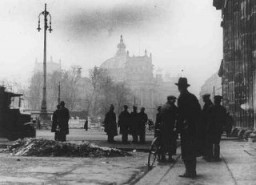
-
Police headquarters
PhotoHeadquarters of the Nazi Gestapo (secret state police) and of the Reich Security Main Office (RSHA). Berlin, Germany, date uncertain.
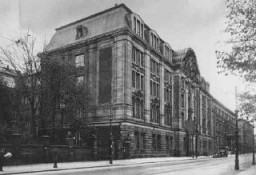
-
The Kusserow family home in Bad Lippspringe
PhotoThe Kusserow family home in Bad Lippspringe. The family, Jehovah's Witnesses, kept religious materials in the trunk of the car and distributed them from it as well. The Kusserow family was active in their region distributing religious literature and teaching Bible study classes in their home. Their house was conveniently situated for fellow Witnesses along the tram route connecting the cities of Paderborn and Detmold. For the first three years after the Nazis came to power, the Kusserows endured moderate…
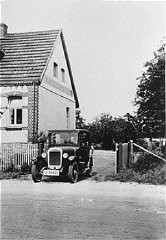
-
Beginning of the torch relay for the 1936 Olympic Games
PhotoA runner begins the torch relay (the first "Olympia Fackel-Staffel-Lauf") in Oympia, Greece., ca. July 1936. The 1936 Games were the first to employ the torch run. Each of 3,422 torch bearers ran one kilometer (0.6 miles) along the route of the torch relay from the site of the ancient Olympics in Olympia, Greece, to Berlin. Former German Olympian Carl Diem modeled the relay after one that had been run in Athens in 80 B.C. It perfectly suited Nazi propagandists, who used torchlit parades and rallies to…
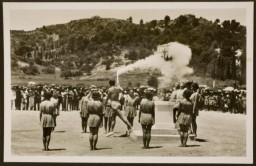
-
1936 Olympics: Torch Relay
Media EssayThe 1936 Olympics in Berlin were the first to employ the torch relay, an Olympic ritual. The Nazi regime used the Olympics to present the false image of a peaceful Germany.
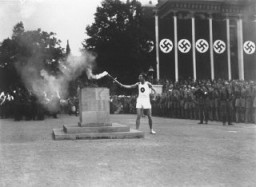
-
Training for emigration
FilmMembers of a German Zionist youth group learn farming techniques in preparation for their new lives in Palestine. Many Jewish youths in Nazi Germany participated in similar programs, hoping to escape persecution by leaving the country.
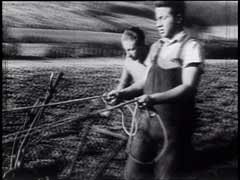
-
Jehovah's Witness Karl-Heinz Kusserow
PhotoKarl-Heinz Kusserow, a Jehovah's witness who was imprisoned by the Nazis because of his beliefs. He was a prisoner in the Dachau and Sachsenhausen concentration camps in Germany.

-
Part of the Der ewige Jude exhibition
PhotoAt Der ewige Jude (The Eternal Jew), a Nazi anti-Jewish propaganda exhibition, a case features "typical Jewish external features." Munich, Germany, November 1937.
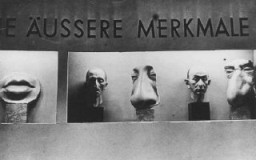
-
Horst Wessel leads his SA formation through the streets
PhotoHorst Wessel leads his SA formation through the streets of Nuremberg during the fourth Nazi Party Congress in August 1929.

-
Weimar-era police search SA men for weapons
PhotoPolice search members of the SA (Sturmabteilung) for weapons as they gather for a rally. This photo was taken during the years of the Weimar Republic, before the Nazi rise to power. Germany, 1929–1932.

-
Dachau concentration camp
Animated MapView an animated map showing key events in the history of the Dachau concentration camp, which was established by the Nazi regime in 1933.

-
Wolfgang Kusserow
ID CardWhen Wolfgang was an infant, his parents became Jehovah's Witnesses. His father moved the family to the small Westphalian town of Bad Lippspringe when Wolfgang was 9. Their home became the headquarters of a new Jehovah's Witness congregation. Wolfgang and his ten brothers and sisters grew up studying the Bible daily. 1933-39: The Kusserows were under close scrutiny by the Nazi secret police because of their religion. As a Jehovah's Witness, Wolfgang believed that his highest allegiance was to God and His…

-
Sign excluding Jews from public places
ArtifactSigns excluding Jews, such as the sign shown here, were posted in public places (including parks, theaters, movie houses, and restaurants) throughout Nazi Germany. This sign states in German: "Jews are not wanted here."

-
Chart of Prisoner Markings
ArtifactA chart of prisoner markings used in German concentration camps. Dachau, Germany, ca. 1938–1942. Beginning in 1937–1938, the SS created a system of marking prisoners in concentration camps. Sewn onto uniforms, the color-coded badges identified the reason for an individual’s incarceration, with some variation among camps. The Nazis used this chart illustrating prisoner markings in the Dachau concentration camp.
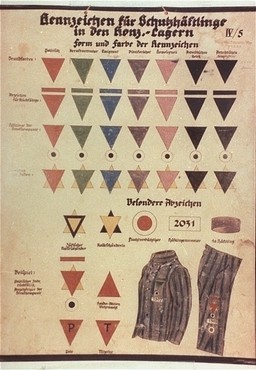
-
Exhumations at Hadamar
FilmThe Hadamar psychiatric hospital was used as a euthanasia killing center from January until August 1941. Nazi doctors gassed about 10,000 German patients there. Although systematic gassings ended in September 1941, the killing of patients continued through the end of the war. In this footage, American soldiers supervise the exhumation of the cemetery at Hadamar and begin the interrogation of Dr. Adolf Wahlmann and Karl Wilig, who participated in the killings.
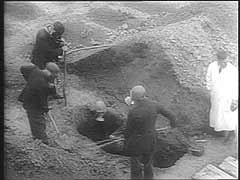
-
Scenes from the liberation of Buchenwald
FilmThe Buchenwald camp was one of the largest concentration camps. The Nazis built it in 1937 in a wooded area northwest of Weimar in central Germany. US forces liberated the Buchenwald camp on April 11, 1945. When US troops entered the camp, they found more than 20,000 prisoners. This footage shows scenes that US cameramen filmed in the camp, survivors, and the arrival of Red Cross trucks.
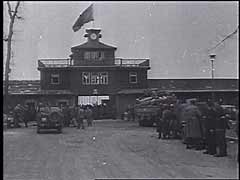
-
Poster for the antisemitic museum exhibition Der ewige Jude
PhotoPoster for the antisemitic museum exhibition Der ewige Jude (The Eternal Jew) characterizes Jews as Marxists, moneylenders, and enslavers. Munich, Germany, November 8, 1937. Nazi propagandists also created a film of the same name.

-
Site of meeting between Neville Chamberlain and Adolf Hitler
PhotoGerman citizens stand outside the decorated Hotel Dreesen, where Neville Chamberlain and Hitler held their second meeting on the Sudetenland and German demands for Czech territory. Nazi flags and the Union Jack fly from the building. Bad Godesberg, Germany, September 22, 1938.

-
Nuremberg Race Laws
ArticleLearn more about the Reich Citizenship Law and the Law for the Protection of German Blood and German Honor, collectively known as the Nuremberg Race Laws.
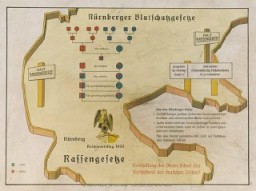
-
Writing the News
ArticleShortly after taking power in January 1933, Adolf Hitler and the Nazis took control of German newspapers, detailing how the news was to be reported.

-
Subsequent Nuremberg Proceedings, Case #11: The Ministries Case
ArticleThe Ministries Case was Case #11 of 12 Subsequent Nuremberg Proceedings against leading German industrialists, military figures, SS perpetrators, and others.
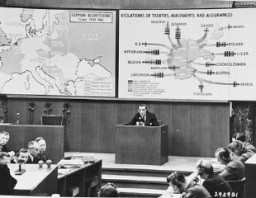
-
Introduction to the Holocaust
ArticleLearn about the Holocaust, the systematic, state-sponsored persecution and murder of six million Jews by the Nazi regime and its collaborators.

-
Fritz Alexander Rosenberg
ID CardFritz was one of three sons born to a Jewish family in the university city of Goettingen, where the Rosenbergs had lived since the 1600s. His father owned a linen factory. Fritz worked as a salesman there, and later he and his brothers inherited the business. In 1913 Fritz married Else Herz. By the early 1920s they had two sons and a daughter. 1933-39: In 1933 the Nazis came to power in Germany. A year later the Rosenbergs' factory was seized and three Nazis came to the family's home. An officer set a gun…

